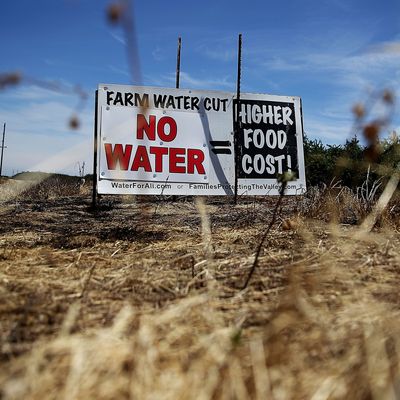
The earth in California is parched. Golf courses have turned brown; farmland is cracking; the state has been running a water deficit of over 11 trillion gallons. But Californians don’t seem to be able to change their water habits. In April, Governor Jerry Brown passed an edict mandating that Californians cut their water usage by 25 percent, but a report recently issued by California’s State Water Resources Control Board showed that California residents and businesses used only 3.6 percent less water in March than they did during the same month in 2013. “There’s a messaging failure out there somewhere,” Felicia Marcus, chairwoman of the State Water Resources Control Board told the New York Times. “ … [P]eople know there is a drought, but they just are not doing enough.”
Viviane Seyranian, a social psychology professor at California State Polytechnic University who studies environmental messaging, agreed, and said that the state’s leaders simply haven’t done enough to motivate people to adopt water-budgeting mind-sets. “People are getting a lot more out of using water than conserving water,” she told Science of Us.
How do you change this? In a study published last month in the Journal of Environmental Psychology, Seyranian and three colleagues tested three different approaches to convincing people to use less water. For the study, 374 households received one of four different brochures — three of them containing interventions designed to encourage them to reduce water, the fourth, sent to the control group, consisting of straightforward tips for doing so.
Later on, the researchers checked each households’ water meters and found that the relative short- and long-term water consumption went down for households in the intervention groups. Overall, none of the groups’ total water use went down — partly, the researchers think, because the study took place in July and August, August being L.A.’s hottest month. But households targeted by the three non-control interventions did appear to reduce their short- and long-term water usage significantly (the effect was larger for households with greater baseline water usage).
Here are the three approaches that worked:
Neighborly Competition
This idea hinges upon the psychological concept called “social norms feedback,” which feeds people information about their peers’ positive behavior in hopes that they will feel nudged to engage in those behaviors as well. Seyranian and her team gave each household a printout comparing its water consumption with the neighborhood average. At the bottom was a score and either a smiley or a frowny face corresponding to their water-usage habits. This approach, already used by energy companies like Opower, “is one of the oldest known ways to get people to make an environmental behavior change,” said Seyranian.
Join the Club
A powerful way to get people to feel like they’re getting a social benefit by going green is to tie the green behavior to some kind of group identity. Seyranian calls this method “social identity framing.” In their own experiment, Seyranian and her team used marketing materials that linked pride for the city to water conservation. For example, a line in their brochure read, “Starting from our environmentally friendly architecture to our clean city vehicles and green building programs, caring for our environment is part of who we are … That’s why with looming water shortages and predictions of long-term drought, our city has crafted its most comprehensive water resource plan ever … Residential water conservation is a critical part of that plan.”
While this method may seem obvious, Seyranian says that cities and companies need to make a conscious effort to employ it when trying to convince people to change their behavior. “We all know this intuitively, but when it comes down to the messaging, we don’t always do it,” she said.
I Want You (to Save Water)
Another method that Seyranian and her team tested is called “personal identity framing.” This method appeals to the individual by making the individual feel like they’re being spoken to personally. The most famous example of personal identity framing is the 1917 army recruitment poster featuring Uncle Sam pointing at the viewer and the words “I Want You for U.S. Army,” with the word you emphasized in red.
In their experiment, Seyranian and her team passed out marketing communication that appealed to each person to do their individual part in helping California conserve water by using the same language as the brochures in the social-identity experiment, but switching out the words our for your and we for you. The two methods were about equally effective.
It’s important to note that the control group, which just received information on how to save water — advice to, for instance, only run dishwashers and washing machines that are full or to defrost meat in the refrigerator overnight instead of under running water — saw the largest increase in water usage. The researchers think that in addition to the August heat, the increase may have been caused by a boomerang effect in which people purposely went against the suggestions in the water tips because they felt like their freedom to control their own water usage was being threatened.
In any case, anyone who has chucked informational mailings in the recycling bin or tuned out while someone lectured them on environmental issues knows that information alone usually isn’t enough to motivate someone to change their behavior. That’s because “information alone doesn’t bring up anything socially meaningful,” said Seyranian. “But using any of the other methods, you can get a sense of belonging or personal fulfillment that may be powerful enough to get you to change.” And change is what an increasingly dried-stricken California desperately needs.




